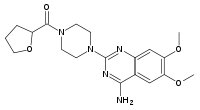You are here: Urology Textbook > Drugs in Urology > Alpha blocker > Terazosin
Alpha Blocker Terazosin: Adverse Effects and Dosage
- Alpha blockers: General pharmacology
- Alpha blocker Alfuzosin
- Alpha blocker Doxazosin
- Alpha blocker Silodosin
- Alpha blocker Tamsulosin
- Alpha blocker Terazosin
Terazosin is a nonselective α1-blocker with a long elimination half-life. Please see section general pharmacology of alpha blocker.
 |
Indications for Terazosin
- Treatment of benign prostatic hyperplasia: Terazosin improves urinary flow and bladder emptying, relieves irritative and obstructive urinary symptoms (LUTS), reduces the risk of urinary retention, improves the success of a trial without a catheter after urinary retention, and is approved for long-term use.
- Treatment of arterial hypertension as a second-line add-on in patients with insufficient effect of the first-line medication.
- Off-label treatment of female LUTS due to neurogenic bladder neck obstruction.
- Off-label treatment: improve the spontaneous passage of distal ureteral stones.
Pharmacokinetics of Terazosin
- Well absorbed after oral administration,Bioavailability 90%
- High protein binding, hepatic metabolism (CYP3A4), elimination half-life 10–18 hours
- Time to steady-state 4–5 days.
Adverse Effects of Terazosin
Increased risk for cardiovascular side effects since terazosin is a nonselective α1 blocker.
- The overall rate of side effects is 10–30%; selective alpha1A-blocker have a reduced cardiovascular side effect rate.
- Initial hypotension, orthostatic collapse, reflex tachycardia, usually transient.
- Increased risk (HR 1,2) of cardiac failure in patients with cardial comorbidity (Lusty et al., 2021).
- Stuffy nose
- Retrograde ejaculation
- Dizziness, weakness.
- Rare side effects: priapism (alpha blocker inhibit sympathetic mechanisms for detumescence), intraoperative floppy iris syndrome during cataract surgery.
Contraindications of Terazosin
Urological Contraindications:
Conservative treatment of BPH with terazosin is not indicated, if surgical treatment is imperative: chronic urinary retention with renal failure, recurrent hematuria due to prostatic enlargement, recurrent urinary tract infections and bladder stones.
Cardiac Contraindications:
Hypotension, mechanical heart failure (valvular diseases, pulmonary embolism, pericarditis), congestive heart failure.
Other contraindications:
Terazosin should be paused perioperatively for cataract surgery to prevent an intraoperative floppy iris syndrome.
Drug interactions
- Increased hypotensive effect with other antihypertensives or phosphodiesterase-5 inhibitors.
- CYP3A4 inhibitors such as ketoconazole increase the terazosin plasma level and side effects.
- Do not combine terazosin with another alpha blocker for better treatment effect.
Dosage of Terazosin
2–10 mg orally once daily, titrate dosage after treatment results and side effects, first week 1 mg, second week 2 mg, third week 5 mg, if necessary and possible fourth week 10 mg. Terazosin should be given in the evening before bedtime to reduce side effects.
| Alpha blocker | Index | Doxazosin |
Index: 1–9 A B C D E F G H I J K L M N O P Q R S T U V W X Y Z
References
Chapple 2004 CHAPPLE, C. R.:
Pharmacological therapy of benign prostatic hyperplasia/lower urinary
tract symptoms: an overview for the practising clinician.
In: BJU Int
94 (2004), Nr. 5, S. 738–44
Fusco et al., “Alpha-Blockers Improve Benign Prostatic Obstruction in Men with Lower Urinary Tract Symptoms: A Systematic Review and Meta-analysis of Urodynamic Studies.,” Eur Urol., vol. 69, no. 6, pp. 1091–1101, 2016, doi: 10.1016/j.eururo.2015.12.034.
C. de Mey, “alpha(1)-blockers for BPH: are there differences?,” Eur Urol, vol. 36 Suppl 3, pp. 52–63, 1999.
 Deutsche Version: Terazosin
Deutsche Version: Terazosin
Urology-Textbook.com – Choose the Ad-Free, Professional Resource
This website is designed for physicians and medical professionals. It presents diseases of the genital organs through detailed text and images. Some content may not be suitable for children or sensitive readers. Many illustrations are available exclusively to Steady members. Are you a physician and interested in supporting this project? Join Steady to unlock full access to all images and enjoy an ad-free experience. Try it free for 7 days—no obligation.
New release: The first edition of the Urology Textbook as an e-book—ideal for offline reading and quick reference. With over 1300 pages and hundreds of illustrations, it’s the perfect companion for residents and medical students. After your 7-day trial has ended, you will receive a download link for your exclusive e-book.